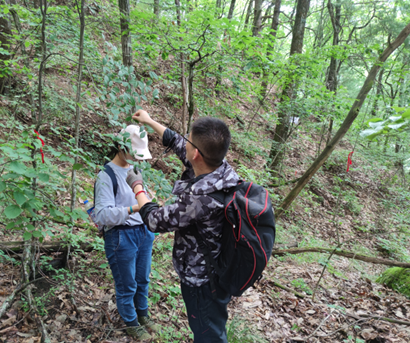Shihong Jia and Bastien Castagneyrol discuss their article: ‘Neighbouring tree effects on leaf herbivory: insect specialization matters more than host plant leaf traits.’
Background
Insect herbivores feed on plants and play a crucial role in determining plant performance, population, and community dynamics. This role is particularly significant in forests where insect herbivores can change the composition of the canopy by damaging seedlings and saplings. But how is the strength of insect herbivory influenced by a plant’s neighbours?

This is not a novel question. For example, the Janzen-Connell hypothesis suggests that insect herbivores may put more pressure on seedlings or saplings that are growing close to adult trees of the same species. In other words, plants surrounded by more diverse neighbours may experience less pressure from insect herbivores.
An increasing number of studies that have looked at how neighbouring trees affect insect herbivory in highly controlled experiments. Researchers have found that mixed stands of trees are more resistant to herbivory than monocultures. The reasons for this can be complex. For example, a previous study has shown that neighbouring trees cause modifications to leaf traits which helps protect plants from insects.
There is strong experimental support in favour of a beneficial effect of tree diversity on tree resistance to insect herbivores. Although highly controlled experiments are powerful tools to isolate the factors effecting herbivory, they often oversimplify the reality. Hence, a question arises: does tree diversity reduce insect herbivory in young trees in the highly complex world of forests, and if so, how?
The ideas behind our study
Insects adopt different strategies to feed on plants. For example, “chewers”, as their name suggests, chew on plant leaves and can move freely between leaves and trees if they dislike their food or location. These include mobile species, such as many coleoptera and free-feeding caterpillars. In contrast, “Miners” live within leaves and, therefore, have no possibility of escaping from a poor food source. Given that most research to date has concentrated on chewers, we were interested in understanding how neighbouring tree effects varied with other forms of herbivory. We hypothesized that there would be more specialization in miners than in chewers, leading to a stronger association between neighbouring trees and leaf herbivory.
Our study

We investigated the effect of the diversity and identity of neighbouring trees on leaf traits and insect herbivory in saplings of nine species of deciduous trees, in a warm-temperate deciduous forest in central China.
Overall, we measured leaf damage caused by insect chewers and miners on 7,372 leaves from 442 saplings. We quantified five leaf traits known to be important in attracting or deterring insect herbivores: specific leaf area, thickness, and carbon: nitrogen ratio, as well as sodium and silicon content, for a subset of the saplings. We surveyed all trees with a diameter at breast height greater than or equal to 5 cm that were located within a radius of 20 m of the focal sapling. We calculated neighbouring tree species diversity, phylogenetic diversity, and conspecific density.
What we found

We found that the diversity and identity of neighbouring trees influenced the level of leaf mining damage but not chewing herbivory. While leaf traits affect the level of herbivory, the diversity and identity of neighbouring trees had little effect on the leaf traits of focal saplings.
Our study addressed a long-standing and important question: to what degree does the strength of insect herbivory on plants varies with neighbouring plant species diversity and identity. We confirmed in the real world what has previously been inferred from highly controlled experiments. We went one step further and highlighted the importance of considering the specialization of insect herbivores in understanding the impacts of neighbouring trees on herbivory, especially in natural forests.
Lessons we learned
Our study has implications for forest management since it implies that increasing the diversity of adult tree neighbours, especially for distantly related species, may be important to reducing the damage caused by specialized insect herbivores.
